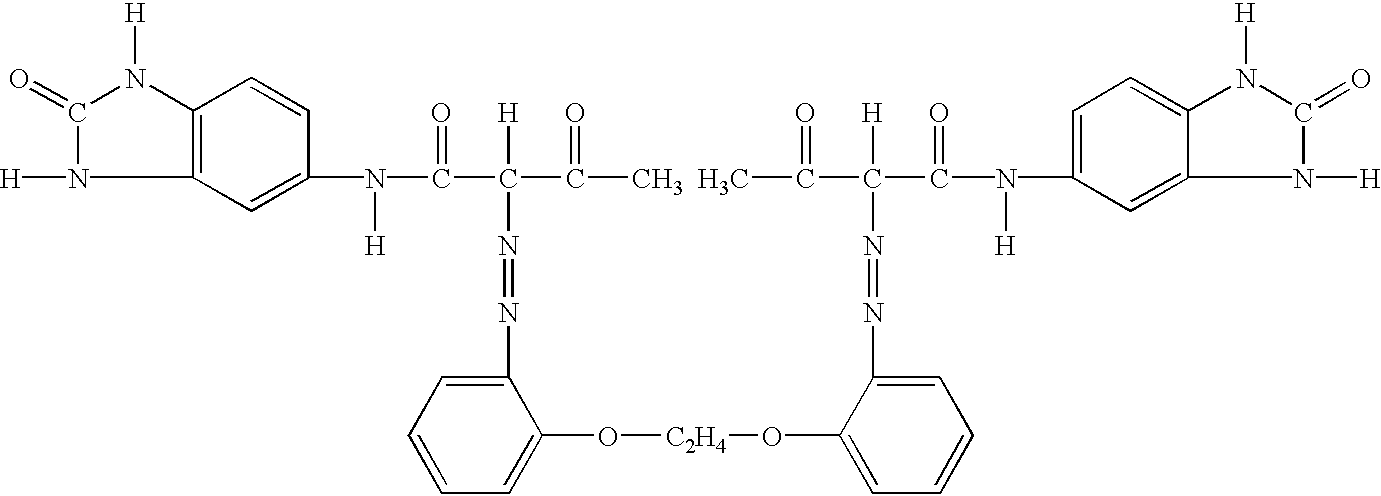Organic pigment with high transparency and hydrophobicity
a technology of organic pigments and hydrophobicities, applied in the field of organic pigments with high transparency and hydrophobicity, can solve the problems of not being applied in the field of hydrophobic properties, means improving a transparency and the application of utilizing
- Summary
- Abstract
- Description
- Claims
- Application Information
AI Technical Summary
Benefits of technology
Problems solved by technology
Method used
Image
Examples
example 1
[0031] 345 g of 1,2-bis(2-aminophenoxy)ethane was added into 4,500 ml of water, and then 654 ml of 35%-hydrochloric acid was added thereto. The resultant solution was stirred for 15 minutes.
[0032] After chilling by adding ice, 423 ml of 38%-sodium nitrite aqueous solution was dropped into the solution to diazotize 1,2-bis(2-aminophenoxy)ethane. After absorbing impurities with an active carbon, etc., the solution was filtered.
[0033] On the other hand, 750 g of 5-acetoacetylamino-benzimidazolone was added into 6,000 ml of water, it was stirred for 10 minutes and the temperature of the solution was made to 20-25.degree. C.
[0034] 880 ml of aqueous sodium hydroxide (29%) was added thereto and was filtered after stirring for 10 minutes.
[0035] The filtrate was made to be 12,000 ml with water and ice, and then 676 ml of acetic acid (80%) was added thereto at 5.degree. C. taking for 20 minutes to form a slurry.
[0036] This coupling component and aforementioned diazo component were made coupli...
example 2
[0042] The coupling was conducted in the same manner as Example 1. The reaction solution was heated up to 90.degree. C. and was kept at this temperature for more than 15 minutes.
[0043] The slurry was cooled down, it was filtered and washed. The press-cake obtained was removed into an autoclave, and 4,000 ml of water and 6,000 ml of isobutanol were added thereto to form a homogenous slurry.
[0044] 500 g of amide wax emulsion (solid content 20%) was added to the slurry. Then it was heated up at the temperature of 80.degree. C. or higher and was kept at this temperature for more than 2 hours.
[0045] After cooling, isobutanol was collected from the slurry. Then the slurry was filtered, washed, dried up and milled to obtain approximately 1,100 g of Pigment Yellow 180.
example 3
[0046] The coupling was conducted in the same manner as Example 1, the reaction solution was heated up to 90.degree. C. and was kept at this temperature for more than 15 minutes.
[0047] This slurry was cooled down, filtrated and washed. The press-cake obtained was removed into an autoclave, and 4,000 ml of water and 6,000 ml of isobutanol were added thereto to form a homogenous slurry.
[0048] 322 g of oxidized polyethylene wax emulsion (solid content 31%) was added to the slurry and it was heated up at the temperature of 80.degree. C. or higher and was kept at this temperature for more than 2 hours.
[0049] After cooling, isobutanol was collected from the slurry. Then the slurry was filtered, washed, dried up and milled to obtain approximately 1,100 g of Pigment Yellow 180.
[0050] Comparison with Pigment Yellow 180 so far Applied
PUM
| Property | Measurement | Unit |
|---|---|---|
| temperature | aaaaa | aaaaa |
| temperature | aaaaa | aaaaa |
| temperature | aaaaa | aaaaa |
Abstract
Description
Claims
Application Information
 Login to View More
Login to View More - R&D
- Intellectual Property
- Life Sciences
- Materials
- Tech Scout
- Unparalleled Data Quality
- Higher Quality Content
- 60% Fewer Hallucinations
Browse by: Latest US Patents, China's latest patents, Technical Efficacy Thesaurus, Application Domain, Technology Topic, Popular Technical Reports.
© 2025 PatSnap. All rights reserved.Legal|Privacy policy|Modern Slavery Act Transparency Statement|Sitemap|About US| Contact US: help@patsnap.com

